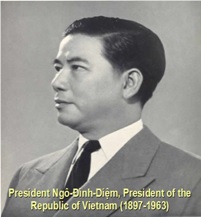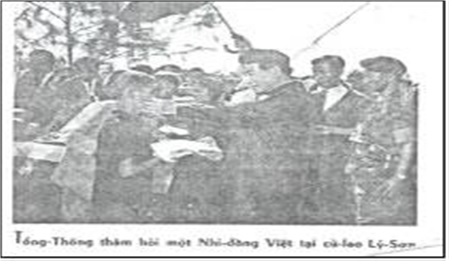The President Ngo Dinh Diem to maintain sovereignty over the “East” Sea especially the Paracels (aka Hoang Sa) and Spratly (aka Truong Sa) Islands

On April 20, 1954, the Geneva Accords was signed; and divided the country into two regions: The north, Ho Chi Minh communist governed the so-called “Democratic Republic of Vietnam.” The South, the Republic of Vietnam was led by Prime Minister Ngo Dinh Diem.
According to the Geneva Accords, after two years of dividing the country, the two regions of Vietnam must hold elections to unify the country. However, the Government of the Republic of Vietnam protested based on the arguments that it was not accepting the division of the country as well as not taking part of signing the Geneva Accord. As such, it has no obligation to enforce this provision of the Accord.
Thus, the Republic of Vietnam and the Democratic Republic of Vietnam are two separate nations, with two completely different political regimes. The Republic of Vietnam advocated democracy, peace, humanism, free economy; The Democratic Republic of Vietnam upheld the dictatorship, party rule, centralized economy, and the development of communism doctrine.
On October 26, 1955, President Ngo Dinh Diem announced the founding of the Republic of Vietnam and the Armed Forces of the Republic of Vietnam (formerly the Vietnam National Army).
To maintain sovereignty over the “East” Sea, President Ngo Dinh Diem issued decrees defining the inviolable sovereignty of Vietnam in the East Sea, especially the Paracel and Spratly Islands.
The 1954 Geneva Accord divided Viet Nam but also recognized that the two archipelagos Hoang Sa, Truong Sa are the Republic of Vietnam’s integral parts. In April 1956, when French troops withdrew from South Vietnam, the South Vietnamese government troops took over the said islands and archipelagos in the East Sea.
On August 22, 1956, the Republic of Vietnam Army landed on the main islands of the Spratly Islands, set up a pillar of sovereignty and hanged the Yellow Flag with Red stripes on the islands.
On October 22, 1956, President Ngo Dinh Diem, via Decree No. 143 / NV, ordered to change the boundaries of provinces and towns in the South. According to the re-listing of all administrative units, Ba Ria - Vung Tau was changed to Phuoc Tuy; and Hoang Sa (Spratly) in Truong Sa archipelago belonging to Phuoc Tuy province with the same name as Paracels in the north.
On July 13, 1961, the President of the Republic of Vietnam: Ngo Dinh Diem signed the Decree No. 174 / NV in which, it placed the Hoang Sa archipelago directly under Thua Thien (now Quang Nam province). – According to “President Ngo Dinh Diem: who has left historical footsteps on Hoang Sa” by Han Giang Tran Le Tuyen.

Photo of President Ngo Dinh Diem visited Ly Son Island, also known as Cu Lao Re, in the Hoang Sa archipelago in 1961.
President Ngo Dinh Diem in the late 1950s and early 1960s also exercised Vietnamese sovereignty over the East Sea, the Spratly Paracel Islands as the Tay Son and the Nguyen Kings did. The picture above is the eloquent confirmation of the sovereignty of the Republic of Vietnam.
The East Sea, the Paracel Islands, the Spratly Islands have a great strategic importance to dominate Southeast Asia and the maritime world, as well as abundant oil reserves. For those reasons, the communist bloc, especially the Chinese communists have tried to take over with any price.
By Dong tinh hoai Ngo
English version by V.G.Tran
Ủng hộ https://truclamyentu.info; generalhieu.info qua Paypal: truclamquansu.info@yahoo.com. Cám ơn
Support for https://truclamyentu.info; https://generalhieu.info via Paypal: truclamquansu.info@yahoo.com. Thanks.
Images | website template by ARaynorDesign
Thư-Viện Bồ Đề Online @ Trúc-Lâm Yên-Tử
